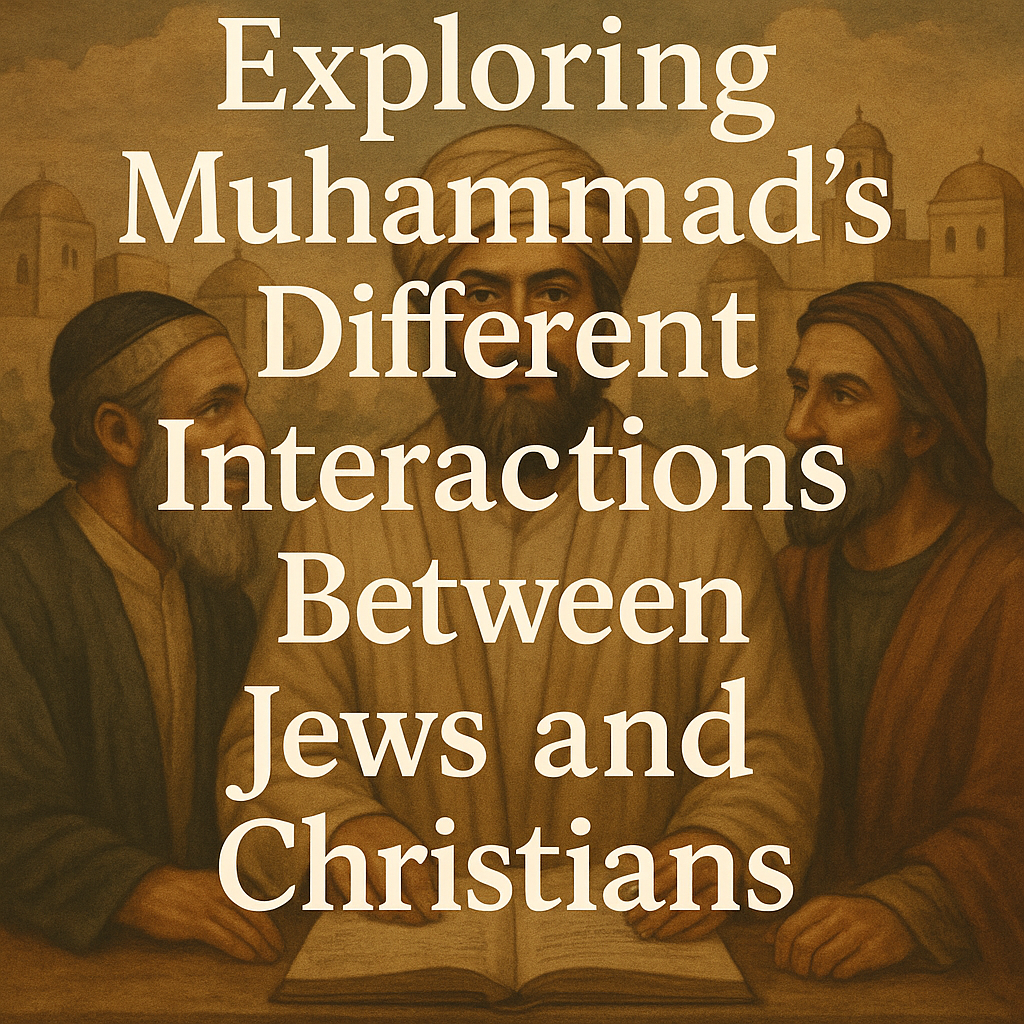

By Dr. Tim Orr
If you read the Qur’an closely, especially the later Medinan surahs, you’ll notice something deeper than theology—whether you’re a student of religion, a secular academic, or someone from an interfaith background, it’s the sound of rejection wrapped in divine speech. It’s not just about laws or doctrine; it’s the unfolding story of a prophet wounded by rejection and compelled to respond. For Muhammad, the Jewish tribes of Medina—Banu Qaynuqa, Banu Nadir, and Banu Qurayza—were not merely theological opponents; they were expected allies. He had hoped they would affirm his message, embrace his role as a prophet, and join him in a common Abrahamic mission. When that hope collapsed, the pain left a mark—not just on the man, but on the revelation itself. The Qur’an became not only divine instruction but emotional processing—God’s message, yes, but also Muhammad’s lament.
The Sīra: A Sacred Biography with Scholarly Caveats
To understand how deep this emotional rupture ran, we need to consider the Sīrat Rasūl Allāh., though it’s important to note that many scholars question its historical reliability due to its compilation over a century after Muhammad’s death and its theological agenda, or “The Life of the Messenger of God.” This early biography of Muhammad, compiled by Ibn Ishaq and later translated by Alfred Guillaume, is the most influential narrative of the Prophet’s life and mission. Though written over a century after Muhammad’s death, it remains the foundational text for most Muslims when recounting the Prophet’s story. Muslims across the world treat the Sīra not as speculative history but as sacred biography—a source of insight into Muhammad’s character, struggles, and revelations. Within it, we see a prophet who extends covenants of peace to Jewish tribes, only to face betrayal and opposition in return. These betrayals were not just political setbacks; they were personal wounds. And those wounds echo in the pages of the Qur’an.
Emotional Wounds and Rejection Sensitivity Theory
Rejection Sensitivity Theory (RST), a psychological framework developed by Geraldine Downey and others, helps us understand how personal experiences of abandonment can shape how individuals react to opposition. Muhammad, who had suffered early loss—losing both parents as a child and growing up on the margins of Meccan society—carried emotional vulnerabilities that likely shaped his expectations and responses. RST suggests that people who experience early rejection become hypersensitive to later rejection, interpreting slights not as misunderstandings but as betrayals. When the Jewish tribes of Medina refused to recognize his prophethood, the pain was magnified. He wasn’t simply being contradicted; he was being denied by those he saw as natural allies. That rejection didn’t stay internal. It surfaced in the Qur’an’s increasingly severe polemic, particularly in Surahs 4, 5, and 9. These surahs move beyond disagreement—they speak of betrayal, covenant-breaking, and divine wrath.
A Harsher Tone: Jews Versus Christians in Qur’anic Polemic
It is difficult to ignore the fact that Muhammad's rhetoric in the Qur’an was significantly more severe toward the Jews than toward Christians. For example, Surah 5:60 metaphorically likens certain Jews to "apes and swine," while Surah 5:64 condemns their statements about God in deeply emotional terms. Christians, by contrast, are called “nearest in love to the believers” in Surah 5:82. While Christian theology—particularly the Trinity and divinity of Jesus—is clearly rejected, the tone lacks the same level of invective. The discrepancy in tone suggests more than doctrinal disagreement; it hints at deeper emotional and relational dynamics. This contrast warrants attention not just as a literary feature but as a window into the emotional arc of the Prophet’s experience. It reflects how proximity and personal betrayal may have influenced the intensity of Muhammad’s responses.
While the Qur’an critiques Christian theology—especially the divinity of Jesus and the Trinity—the tone is often restrained. Christians are described as mistaken, but never with the same venom. In fact, Surah 5:82 calls Christians “nearest in love to the believers,” while the same surah accuses the Jews of saying “God’s hand is tied up” and calls down a curse upon them (Q 5:64). Jews are portrayed as conspirators, covenant-breakers, and in some cases, metaphorically turned into “apes and swine” (Q 5:60)—language never used for Christians. The difference in tone is striking and consistent. Christians were outsiders; Jews were neighbors who rejected him. And that proximity made their refusal feel like betrayal.
Consider also that Christian delegations, like the one from Najran, engaged Muhammad in theological dialogue without hostile consequences. Their disagreement resulted in a formal exchange and a parting in peace. No such outcome followed Muhammad’s conflicts with the Jewish tribes. Instead, their rejection culminated in the expulsion of Banu Nadir and the execution of Banu Qurayza. The Sīra records these episodes with haunting detail—men judged and beheaded, women and children enslaved. Muhammad’s silence during these moments, as Ibn Ishaq notes, may signal not indifference but internalized emotional devastation. And the Qur’an’s language becomes increasingly legalistic, absolutist, and condemnatory toward the Jews—far more so than toward any other religious group.
Political Pressure and the Rhetoric of Separation
Mark Durie has argued that this rhetoric is more than doctrinal—it’s deeply political and emotional, shaped in large part by Muhammad’s increasing need to consolidate authority amid rising internal dissent and external opposition. According to Durie, the Medinan surahs emerge not in a theological vacuum but in a volatile context of broken treaties, tribal shifts, and mounting hostility. As pressure mounted to defend the nascent Muslim community, revelation took on a more confrontational and boundary-enforcing character. The denunciation of the Jewish tribes thus reflects not just divine judgment but the Prophet’s efforts to preserve unity and obedience in a time of great political instability (Durie, 2010). The betrayal of the Jewish tribes was not just the breaking of treaties; it was the shattering of a hoped-for fraternity.
This is why the Qur’an doesn’t merely clarify theological differences with the Jews—it denounces them. Surah after surah revisits their alleged failures: accusing them of hiding revelation, rejecting prophets, and breaking covenants. This isn’t theological debate. It’s the sacred scripting of separation. Muhammad reinterprets his rejection by the Jews not as a personal failure, but as a prophetic confirmation. He becomes, in his own eyes, another in the long line of messengers scorned by Israel
That emotional register never quite appears in Qur’anic critiques of Christians. While Christian beliefs are clearly refuted—especially the divinity of Jesus—there is no recorded expulsion, no military conflict, and certainly no systematic theological vilification on the same scale. Even the Qur’an’s warnings to Christians are often wrapped in calls to reason: “Do not say ‘Three’; desist, it is better for you” (Q 4:171). This gentler tone is not accidental. It reflects the fact that Christians were never as socially or emotionally entangled in Muhammad’s world as the Jews were. The distance allowed for disagreement without betrayal—and thus without rage.
In the end, the Qur’an’s later surahs are not simply theological treatises. They reflect a psychological and emotional arc, as explored through Rejection Sensitivity Theory, where Muhammad’s personal longing for recognition—particularly from the Jewish tribes—transforms into a sharper polemical tone. This emotional trajectory parallels what RST describes: the intensification of response when deep hopes are denied. The Qur’anic message, therefore, becomes not just doctrinal clarification but an emotional reframing of rejection as sacred distinction. The theological becomes inseparable from the personal.
By understanding this connection, we gain a fuller appreciation for how revelation and rejection may have been emotionally intertwined. It reminds us that even sacred texts often carry the echo of deeply human experiences. They are, in part, a prophet’s response to emotional trauma. The boundary between divine message and human experience isn’t erased—but it’s blurred. This doesn’t diminish the Qur’an’s spiritual authority for Muslims; rather, it invites us to read it with a fuller understanding of its emotional landscape. Like Jeremiah’s laments or Jesus’ weeping over Jerusalem, Muhammad’s Qur’an contains echoes of rejection, longing, and loss. Pain didn’t silence him. It became scripture. And in that transformation—from heartbreak to holy writ—we see not only a prophet proclaiming truth but a man seeking to be seen.
